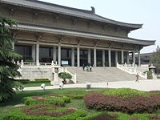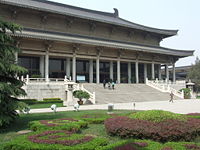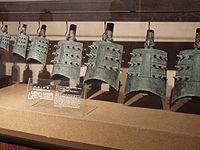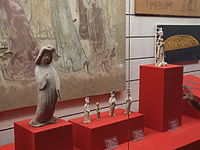
Shaanxi History Museum
Encyclopedia




Giant Wild Goose Pagoda
Giant Wild Goose Pagoda or Big Wild Goose Pagoda , is a Buddhist pagoda located in southern Xi'an, Shaanxi province, China. It was built in 652 during the Tang Dynasty and originally had five stories, although the structure was rebuilt in 704 during the reign of Empress Wu Zetian and its exterior...
in the ancient city Xi'an
Xi'an
Xi'an is the capital of the Shaanxi province, and a sub-provincial city in the People's Republic of China. One of the oldest cities in China, with more than 3,100 years of history, the city was known as Chang'an before the Ming Dynasty...
, in the Shaanxi
Shaanxi
' is a province in the central part of Mainland China, and it includes portions of the Loess Plateau on the middle reaches of the Yellow River in addition to the Qinling Mountains across the southern part of this province...
province of China
China
Chinese civilization may refer to:* China for more general discussion of the country.* Chinese culture* Greater China, the transnational community of ethnic Chinese.* History of China* Sinosphere, the area historically affected by Chinese culture...
, is one of the first huge state museums with modern facilities in China. The museum houses over 300,000 items including murals, paintings, pottery, coins, as well as bronze, gold, and silver objects. The modern museum was built between 1983 and 2001 and its appearance recalls the architectural style of the Tang Dynasty
Tang Dynasty
The Tang Dynasty was an imperial dynasty of China preceded by the Sui Dynasty and followed by the Five Dynasties and Ten Kingdoms Period. It was founded by the Li family, who seized power during the decline and collapse of the Sui Empire...
.
History
Shaanxi History Museum was constructed from 1983. It was opened to the public on 20 June 1991. The museum is in an area of 65,000 square meters, with a building area of 55,600 square meters, cultural relics storerooms of 8,000 square meters, exhibition halls of 11,000 square meters, and a collection of 370,000 objects. The museum is architecturally in the Tang style, with a "hall in center, storied buildings in corners". It is elegant and dignified, on a large scale, with a combination of traditional architecture and modern technology, which embodies folk tradition and local features.Shaanxi was the ancient imperial capital of China, having been the seat of more than 13 feudal dynasties, including the Zhou
Zhou Dynasty
The Zhou Dynasty was a Chinese dynasty that followed the Shang Dynasty and preceded the Qin Dynasty. Although the Zhou Dynasty lasted longer than any other dynasty in Chinese history, the actual political and military control of China by the Ji family lasted only until 771 BC, a period known as...
, Qin
Qin Dynasty
The Qin Dynasty was the first imperial dynasty of China, lasting from 221 to 207 BC. The Qin state derived its name from its heartland of Qin, in modern-day Shaanxi. The strength of the Qin state was greatly increased by the legalist reforms of Shang Yang in the 4th century BC, during the Warring...
, Han
Han Dynasty
The Han Dynasty was the second imperial dynasty of China, preceded by the Qin Dynasty and succeeded by the Three Kingdoms . It was founded by the rebel leader Liu Bang, known posthumously as Emperor Gaozu of Han. It was briefly interrupted by the Xin Dynasty of the former regent Wang Mang...
, and Tang
Tang Dynasty
The Tang Dynasty was an imperial dynasty of China preceded by the Sui Dynasty and followed by the Five Dynasties and Ten Kingdoms Period. It was founded by the Li family, who seized power during the decline and collapse of the Sui Empire...
dynasties. The province is rich in cultural relics. With the completion of the Shaanxi History Museum, it collected over 370,000 precious relics which were unearthed in Shaanxi Province, including bronze wares, pottery figures, and mural paintings in Tang tombs.
Since the opening of the museum, it has followed the policy of collecting, conservation, publicizing, education, and scientific research, using its many historical relics, and conducted various types of display. The relics have also been exhibited overseas in cities in Japan, France, the United States, the United Kingdom and Germany.
Collection highlights
Highlights of the museum include:- Fossils of the Lantian ManLantian ManLantian Man , formerly Sinanthropus lantianensis is a subspecies of Homo erectus. Its discovery in 1963 was first described by J. K...
(preceded Peking Man), - The Deer Pattern Eaves Tile from the Qin DynastyQin DynastyThe Qin Dynasty was the first imperial dynasty of China, lasting from 221 to 207 BC. The Qin state derived its name from its heartland of Qin, in modern-day Shaanxi. The strength of the Qin state was greatly increased by the legalist reforms of Shang Yang in the 4th century BC, during the Warring...
, - The Kneeling Archer, a 120 cm tall figure unearthed in 1977 from Emperor Qin Shi Huang's tomb
- The Four Footed Li, a Shang DynastyShang DynastyThe Shang Dynasty or Yin Dynasty was, according to traditional sources, the second Chinese dynasty, after the Xia. They ruled in the northeastern regions of the area known as "China proper" in the Yellow River valley...
bronze cooking utensil, - Playing Polo, a Tang DynastyTang DynastyThe Tang Dynasty was an imperial dynasty of China preceded by the Sui Dynasty and followed by the Five Dynasties and Ten Kingdoms Period. It was founded by the Li family, who seized power during the decline and collapse of the Sui Empire...
mural of people playing poloPoloPolo is a team sport played on horseback in which the objective is to score goals against an opposing team. Sometimes called, "The Sport of Kings", it was highly popularized by the British. Players score by driving a small white plastic or wooden ball into the opposing team's goal using a...
in China, - The Empress's Seal, a jade seal from the Western Han Dynasty, excavated near the tomb of Emperor Gao Zu, the first emperor of the Han DynastyHan DynastyThe Han Dynasty was the second imperial dynasty of China, preceded by the Qin Dynasty and succeeded by the Three Kingdoms . It was founded by the rebel leader Liu Bang, known posthumously as Emperor Gaozu of Han. It was briefly interrupted by the Xin Dynasty of the former regent Wang Mang...
— one of the most important imperial seals ever found in China.

